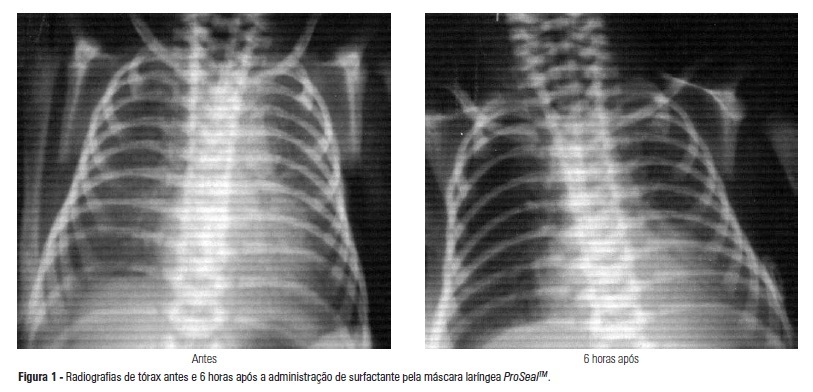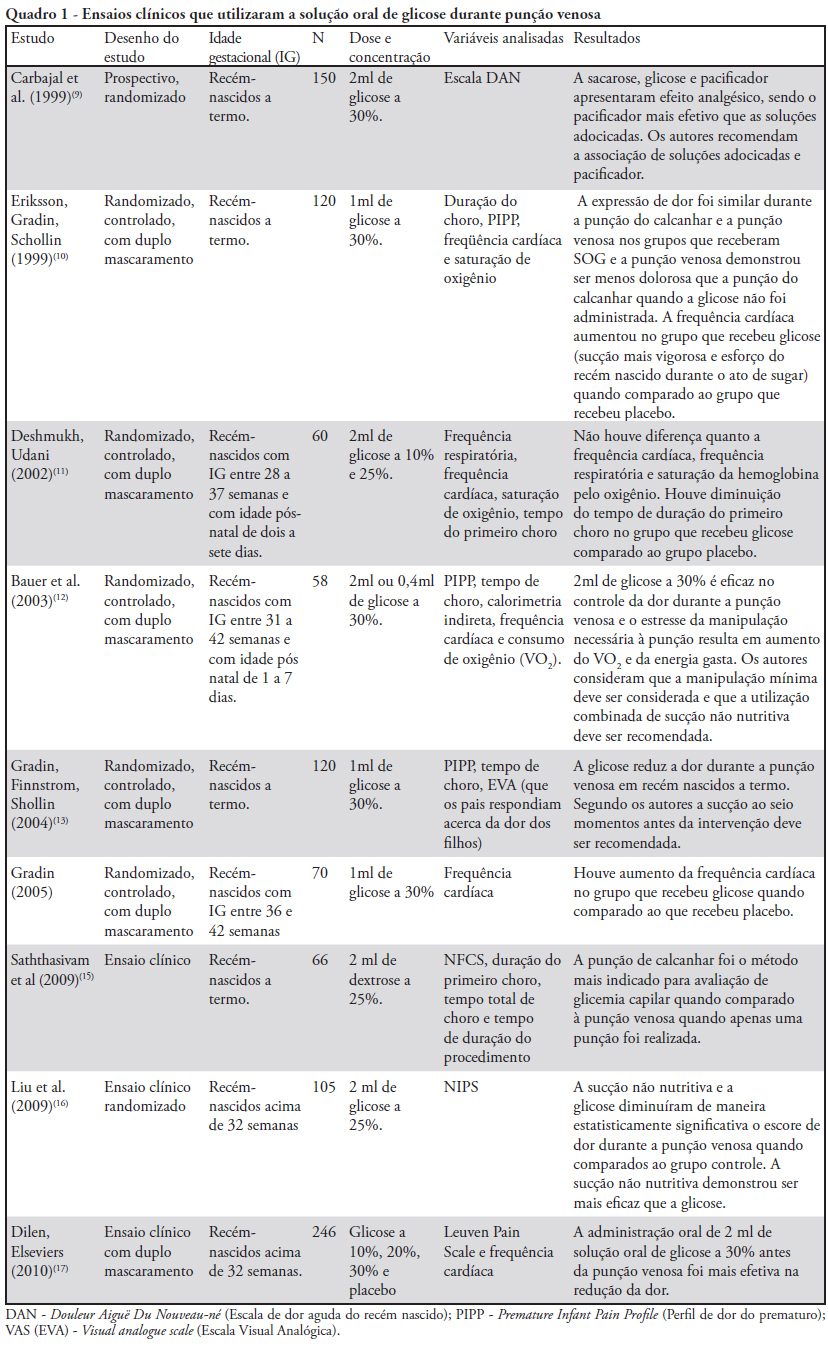You searched for:"Juliana de Oliveira Marcatto"
We found (5) results for your search.-
Original Article
Assessment of newborn pain during arterial puncture: an observational analytical study
Rev Bras Ter Intensiva. 2021;33(3):434-439
Abstract
Original ArticleAssessment of newborn pain during arterial puncture: an observational analytical study
Rev Bras Ter Intensiva. 2021;33(3):434-439
DOI 10.5935/0103-507X.20210058
Views0See moreABSTRACT
Objective:
To evaluate pain intensity during arterial puncture performed in newborns admitted to a neonatal progressive care unit and to evaluate the perception of health professionals regarding neonatal pain.
Methods:
This was an observational analytical study in which 62 arterial punctures were performed in 35 neonates. Pain was assessed during collection using the Premature Infant Pain Profile scale. The health professionals responsible for collection evaluated pain using a verbal numerical scale ranging from zero to ten. The data were subjected to descriptive statistical analysis using the Statistical Package for the Social Science software.
Results:
Among the newborns, 30.6% (n = 19) had no pain or mild pain (0 – 6), 24.2% (n = 15) had mild to moderate pain (7 – 11) and 45.2% (28) had severe pain (12 – 21). It was found that health professionals identified pain during the procedure.
Conclusion:
Arterial puncture is considered a painful procedure that can result in mild to severe pain. The adoption of systematic evaluation strategies is necessary to enable appropriate therapeutic intervention.
-
Original Article
Pharmacological and nonpharmacological measures of pain management and treatment among neonates
Rev Bras Ter Intensiva. 2019;31(1):21-26
Abstract
Original ArticlePharmacological and nonpharmacological measures of pain management and treatment among neonates
Rev Bras Ter Intensiva. 2019;31(1):21-26
DOI 10.5935/0103-507X.20190007
Views0ABSTRACT
Objective:
This study sought to describe and quantify the pharmacological and nonpharmacological strategies used to relieve the pain/stress of neonates during hospitalization in neonatal intensive care units.
Methods:
This quantitative, longitudinal, and descriptive study examined 50 neonates from neonatal intensive care unit admission to discharge.
Results:
A total of 9,948 painful/stressful procedures were recorded (mean = 11.25 ± 6.3) per day per neonate. A total of 11,722 pain-management and relief interventions were performed, of which 11,495 (98.1%) were nonpharmacological strategies, and 227 (1.9%) were pharmacological interventions. On average, each neonate received 235 pain-management and treatment interventions during hospitalization, 13 nonpharmacological interventions per day, and one pharmacological intervention every 2 days.
Conclusion:
Neonates receive few specific measures for pain relief given the high number of painful and stressful procedures performed during hospitalization. Thus, it is essential to implement effective pain-relief protocols.
Keywords:analgesiadrug therapyInfant, newbornIntensive care units, neonatalNeonatal nursingPain managementPain/prevention & controlSee more -
Case Report
ProSealTM laryngeal mask airway for surfactant administration in the treatment of respiratory distress syndrome in a premature infant
Rev Bras Ter Intensiva. 2012;24(2):207-210
Abstract
Case ReportProSealTM laryngeal mask airway for surfactant administration in the treatment of respiratory distress syndrome in a premature infant
Rev Bras Ter Intensiva. 2012;24(2):207-210
DOI 10.1590/S0103-507X2012000200018
Views0The administration of surfactant via tracheal cannula with mechanical ventilation is the conventional treatment for infant respiratory distress syndrome. Hemodynamic and respiratory changes due to tracheal intubation and the need for premedication justify the search for less invasive alternatives of surfactant administration. The objective of this study was to describe the use of the ProSealTM laryngeal mask airway as an option for the treatment of respiratory distress syndrome in a premature infant born at 31 weeks of gestation, at 1335 g, with respiratory difficulty after the first hour of life and exhibiting the clinical and radiologic features of respiratory distress syndrome. The surfactant was administered with the use of the ProSealTM laryngeal mask airway at 3.5 hours of life. It was well tolerated, with no need for tracheal intubation. Normal gasometry and radiologic improvement were observed after three and six hours of administration. Oxygen administration was suspended after eight days, with no comorbidities at discharge. The laryngeal mask airway seems to be a painless and less invasive alternative to treat respiratory distress syndrome and may reduce the need for tracheal intubation and mechanical ventilation. The efficacy and advantages of this route of treatment should be confirmed in a study of an adequate sample.
Keywords:administration & dosagedrug therapyInfant, prematureLaryngeal masksRespiratory distress syndrome, newbornSurface-active agentsutilizationSee more
-
Benefits and limitations of the use of glucose for the treatment of pain in neonates: a literature review
Rev Bras Ter Intensiva. 2011;23(2):228-237
Abstract
Benefits and limitations of the use of glucose for the treatment of pain in neonates: a literature review
Rev Bras Ter Intensiva. 2011;23(2):228-237
DOI 10.1590/S0103-507X2011000200017
Views0See moreThis article aims to review the main studies evaluating glucose as a therapeutic alternative during mildly to moderately painful procedures in neonatology, highlighting its benefits and limitations. During their stay in neonatal intensive care units, neonates are constantly subjected to a number of painful procedures without proper therapeutic management, although the medical literature emphatically recommends this type of management, highlighting the deleterious neurological consequences of pain. Most of these interventions are frequently necessary in neonatal intensive care units to maintain clinical stability in these children; the use of systemic analgesia, however, is not considered to be a good option. The administration of oral glucose solution is apparently effective and safe for pain control during procedures causing mild-to-moderate pain in neonate intensive care units, with rare adverse effects; however, its mode of action has not yet been described clearly in the literature. The administration of oral glucose solution is well described for use in venous punctures; it is apparently effective also for heel punctures, especially when associated with nonnutritive sucking, with most studies showing favorable results.

-
Review Articles
Topical anesthesia in preterm neonate: a reflection on the underutilization in clinical practice
Rev Bras Ter Intensiva. 2010;22(1):69-76
Abstract
Review ArticlesTopical anesthesia in preterm neonate: a reflection on the underutilization in clinical practice
Rev Bras Ter Intensiva. 2010;22(1):69-76
DOI 10.1590/S0103-507X2010000100012
Views0See morePremature neonates are customarily submitted to invasive painful procedures during their stay in NICUs that are necessary to maintain their clinically stability. Topical anesthesia is a good option to be considered in the treatment of interventions that lead to mild to moderate pain and has the advantage of no systemic effects. In Brazil the most known topical anesthetic available for use is the eutectic mixture of local anesthetics (EMLA® cream). Its efficacy in the treatment of cutaneous painful procedures is well established for children and adults. Its utilization in neonates has been investigated also due to the risk to develop methemoglobinemia. The procedures in which topical anesthesia would be well indicated are those related to mild to moderate pain like: arterial and venous punction, hell lance puncture, lumbar puncture and percutaneous central catheter installation. The studies in the literature have so far lead to different conclusions, mainly depending on the type of the procedure and also due to the use of very different methodologies. The possibility of a direct pain evaluation may decrease the methodological bias leading to a more accurate evaluation of the efficacy of the topical anesthesia and also allowing comparisons among the indirect pain measures used so far.

Search
Search in:
KEY WORDS
Case reports Child Coronavirus infections COVID-19 Critical care Critical illness Extracorporeal membrane oxygenation Infant, newborn Intensive care Intensive care units Intensive care units, pediatric mechanical ventilation Mortality Physical therapy modalities Prognosis Respiration, artificial Respiratory insufficiency risk factors SARS-CoV-2 Sepsis




